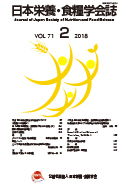
- Issue 6 Pages 267-
- Issue 5 Pages 231-
- Issue 4 Pages 161-
- Issue 3 Pages 117-
- Issue 2 Pages 75-
- Issue 1 Pages 3-
- |<
- <
- 1
- >
- >|
-
Chiemi Yamanaka, Seiichiro Aoe2018Volume 71Issue 2 Pages 75-82
Published: 2018
Released on J-STAGE: April 16, 2018
JOURNAL FREE ACCESSTo measure the effects of dietary calcium levels on pancreatic function, KK/Ta mice were divided into three groups fed a 0.25% (L), 0.5% (M), and 1.0% (H) calcium diet, respectively, each supplemented with calcium carbonate for 7 weeks based on the AIN-93G composition. No significant difference in serum calcium concentrations was observed. However, serum phosphorus concentrations were significantly higher in the H group than in the L and M groups. Moreover, a significant negative correlation between the serum PTH concentration and serum phosphorus concentration was observed. Although no significant difference in serum insulin concentrations was evident, the blood glucose level at 15 and 30 minutes was significantly higher in groups L and H than in group M in the ITT test. Expression of pancreatic function markers was significantly higher in the L group than in the M and H groups. Furthermore, expression of pancreatic inflammation markers was significantly higher in group L than in group H. These results indicate that low calcium intake induces inflammation in the pancreas, leading to insulin resistance. Conversely, the effect of high calcium intake on pancreatic function may be attributable to a different mechanism.
View full abstractDownload PDF (762K)
-
Nobuyuki Tanahashi, Haruka Hiromori, Mai Hayakawa, Chihiro Nonoda, Kon ...2018Volume 71Issue 2 Pages 83-89
Published: 2018
Released on J-STAGE: April 16, 2018
JOURNAL FREE ACCESSRecently, it has been recognized that there are some problems with the criteria used to define the mechanical properties of food for individuals with dysphagia. Therefore, we examined some possible refinements of those criteria. Using plungers with different heights (8 mm or 30 mm) , tea jelly and milk showed no differences in hardness, adhesion and cohesion values, but the use of different speeds did reveal differences in these parameters. When dishes differing in diameter were used, the hardness and adhesion values of tea jelly were significantly higher for a diameter of 40 mm than for 50 mm, whereas the cohesion level for a diameter of 40 mm was significantly lower than for a diameter of 50 mm. In the case of a 50-mm diameter dish, a difference in speed was confirmed for the hardness, adhesion and cohesion of tea jelly. Moreover, for a dish more than 50 mm in diameter, it was recognized that the values of hardness, adhesion and cohesion were constant. These findings suggest that for individuals with dysphagia, the diameter of the dish influences the physical properties of food.
View full abstractDownload PDF (681K)
-
Keiichi Nishimura, Jukai Maeda, Kiyomi Nakamura2018Volume 71Issue 2 Pages 91-97
Published: 2018
Released on J-STAGE: April 16, 2018
JOURNAL FREE ACCESSIn Japan, the concept of “food groups” organized according to similarity, such as “culinary plants” or “meats”, is widely used for food education and diet therapy in the field of nutrition science. In the field of traditional Chinese nutrition, on the other hand, “Shoku-mi”, i.e. the taste of the food itself (Sour, Bitter, Sweet, Hot, and Salty), has some merit, and on this basis foods are classified into several categories. This concept is derived from “Gogyo-ron”, the Chinese traditional theory of five elements in yin-yang, and these five elements are associated with both body organs and “Shoku-mi”. The purpose of this study was to clarify the relationships between food groups and Shoku-mi, as this has never been previously investigated. From among 379 foods described in the Shoku-mi table edited by the Japan Society of Food Science in Chinese Medicine, 291 were classified on the basis of food groups described in the Standard Tables of Food Composition in Japan edited by the Ministry of Education, Sports, Culture, Science and Technology, and the relationships between food groups and Shoku-mi were analyzed using Fisher’s Exact test. It was found that half of the foods analyzed showed “Sweet”. Some statistically significant relationships were found. Those fell into the categories of “Sweet” and “Sugar and Sweeteners”, “Sweet and Sour” and “Fruits”, and “Salty” and “Algae”. This information can be utilized in the field of health promotion using foods.
View full abstractDownload PDF (746K) -
(JSNFS Award for Achievement in Technological Research (2017) )Jun Hemmi, Seiya Makino, Hiroshi Kano, Yukio Asami2018Volume 71Issue 2 Pages 99-102
Published: 2018
Released on J-STAGE: April 16, 2018
JOURNAL FREE ACCESSAs society ages, extension of healthy life expectancy has become a focus of attention in Japan. One way to promote health is taking functional foods. In studies to develop a functional yogurt, we found that Lactobacillus delbrueckii subsp. bulgaricus OLL1073R-1 produced exopolysaccharides with immunomodulatory effects. Intake of yogurt fermented with this strain enhanced natural killer cell activities by inducing the production of interferon-γ (IFN-γ) from splenocytes and ameliorated the severity of influenza virus infection in mice. The yogurt also decreased the risk of catching common cold among healthy elderly individuals and increased the production of antibody after seasonal influenza vaccination in healthy people. These data indicated that intake of this yogurt augmented both innate and adaptive immunity. Furthermore, intake of this yogurt decreased subjective fatigue at times of seasonal temperature fluctuation. Overall, it is considered that intake of this yogurt is likely to be effective for maintenance of health.
View full abstractDownload PDF (749K)
- |<
- <
- 1
- >
- >|